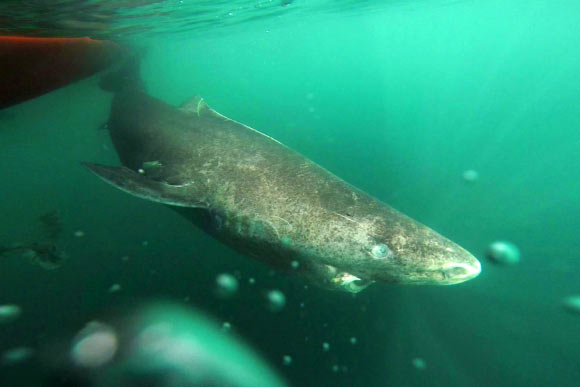Greenland sharks (Somniosus microcephalus) live at least as long as 400 years, according to a team of marine biologists led by Dr. Julius Nielsen from the University of Copenhagen, Denmark.
The Greenland shark, an iconic species of the Arctic Seas, can found from surface waters in shallow estuaries and bays to depths of at least 4,000 feet (1,200 m) in continental shelf and slope waters.
The species is one of the larger sharks and by far the largest of Atlantic-Arctic and Antarctic fishes.
Females are larger than males, and adults typically measure 13 to 16 feet (4-5 m); the maximum length of the species is about 21 feet (6.4 m).
In 1988, a male 19.7 feet (6 m) long was observed at 1.4 miles (2,200 m) on the wreck of the SS Central America off the coast of Savannah, Georgia.
The Greenland shark varies between a uniform black, brown and grey color, although it may be marked with dark lines or white spots along its back and sides. It has short, rounded snouts, small eyes, and small but sharp teeth.
The biology of the species is poorly understood, yet its extremely slow growth rates, at about 0.4 inches (1 cm) per year, hint that this shark benefits from exceptional longevity.
Traditional methods for determining the age of a species involve analyzing calcified tissue, a feature that’s sparse in Greenland sharks.
Therefore, to determine the average age of this species, Dr. Nielsen and his colleagues from Denmark, Greenland, Norway, UK and the United States applied radiocarbon dating techniques to the eye lenses of 28 female Greenland sharks (2.7 to 16.5 feet, or 81 cm to 5.02 m, in total length) caught as by-catch.
The team’s analysis suggests an average lifespan of at least 272 years. The two largest sharks in the study, at 16.2 and 16.5 feet (4.93 and 5.02 m) in length, were estimated to be roughly 335 and 392 years old, respectively.
“Our results demonstrate that the Greenland shark is among the longest-lived vertebrate species surpassing even the bowhead whale (Balaena mysticetus, estimated longevity of 211 years),” Dr. Nielsen and co-authors said.
“The life expectancy of the Greenland shark is exceeded only by that of the ocean quahog (Arctica islandica, 507 years).”
“What’s more, since previous reports suggest that females of this species reach sexual maturity at lengths greater than 4 m (13 feet), the corresponding age would be at least 156 years old,” the scientists added.
Based on these results, published today in the journal Science, the Greenland shark is now the oldest-known vertebrate to roam our planet.
_____
Julius Nielsen et al. 2016. Eye lens radiocarbon reveals centuries of longevity in the Greenland shark (Somniosus microcephalus). Science 353 (6300): 702-704; doi: 10.1126/science.aaf1703








